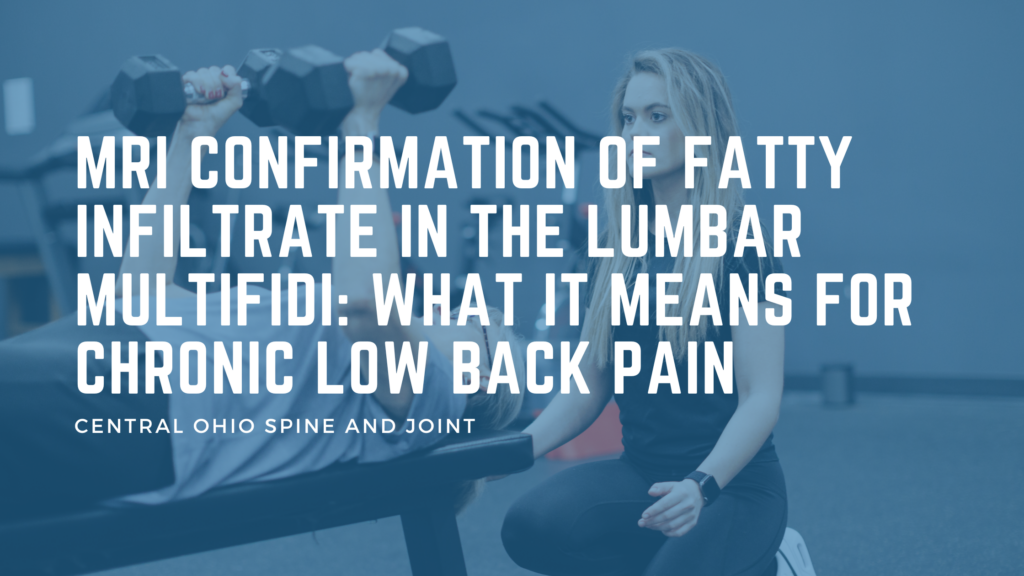When it comes to diagnosing and treating chronic low back pain, imaging can provide critical insights that influence treatment strategies and outcomes. One of the more significant findings on MRI imaging, particularly in patients suffering from persistent low back pain, is the presence of fatty infiltrate in the lumbar multifidi muscles. Understanding what this means can drastically alter the approach to managing and rehabilitating low back issues.
What Are the Lumbar Multifidi Muscles?
The multifidi are small, deep spinal muscles that play a crucial role in stabilizing the lumbar spine. They attach from vertebra to vertebra and work synergistically with other core muscles to maintain proper posture, control spinal movement, and support spinal integrity during activity. Because of their critical stabilizing role, any dysfunction or deterioration in the multifidi can significantly compromise spinal health.
What Is Fatty Infiltration?
Fatty infiltration refers to the process where muscle tissue is replaced by fat. This is not merely a cosmetic issue; it reflects real functional impairment. On MRI, fatty infiltrate appears as areas of increased signal intensity within the muscle belly, indicating that muscle fibers have been lost and replaced with non-contractile, fatty tissue.
This transformation typically occurs due to chronic disuse, nerve injury, aging, or persistent pain inhibition, which prevents the muscle from functioning normally. In the case of the lumbar multifidi, fatty infiltration suggests a significant loss of spinal stability and control.
Why Is Fatty Infiltration in the Multifidi Important for Chronic Low Back Pain?
Multiple studies have established a strong correlation between fatty infiltration of the lumbar multifidi and chronic low back pain. In fact, patients with chronic low back pain often show higher levels of multifidus fatty infiltration compared to asymptomatic individuals.
Key implications include:
- Loss of Spinal Stability: With the multifidi compromised, the lumbar spine loses a vital component of its stabilization system, increasing the mechanical stress on discs, ligaments, and joints.
- Increased Risk of Re-injury: Without strong deep spinal muscles, movements become less controlled and compensations develop, heightening the risk of further injury or chronic strain.
- Persistent Pain Cycle: The pain-inhibition cycle, where pain leads to muscle inhibition, which in turn leads to further weakness and instability, can perpetuate chronic symptoms if not addressed.
- Poor Rehabilitation Outcomes: If fatty infiltration is present and not specifically accounted for in rehab programming, patients may struggle to improve despite conventional therapy.

How Is Fatty Infiltration Diagnosed?
MRI (Magnetic Resonance Imaging) remains the gold standard for identifying fatty infiltration in the multifidi. A radiologist or musculoskeletal specialist can observe changes in the muscle density and report the extent of fatty infiltration. Mild, moderate, or severe grades can be assigned based on the degree of fatty replacement relative to normal muscle tissue.
Ultrasound imaging can also sometimes be used to screen for fatty changes, though it is less precise than MRI.
What Causes Fatty Infiltration of the Multifidi?
Several mechanisms contribute to fatty infiltration, including:
- Disuse Atrophy: Chronic inactivity due to pain or fear-avoidance behaviors.
- Denervation: Nerve injury, particularly involving the dorsal rami, can lead to muscle wasting.
- Post-Surgical Changes: Spine surgery, such as discectomy or laminectomy, can disrupt nerve signaling to these muscles.
- Recurrent Injury: Repetitive back injuries without proper rehabilitation.
- Systemic Factors: Conditions like aging, obesity, or metabolic syndrome may also predispose to fatty changes.
Clinical Implications and Treatment Strategies
Recognizing the presence of fatty infiltration fundamentally changes the approach to treating chronic low back pain.
1. Targeted Rehabilitation
Rehabilitating the multifidi is critical but can be challenging due to the deep location of these muscles. Traditional exercise approaches like general core strengthening may not adequately target the multifidi. Instead, specific techniques must be employed:
- Motor Control Exercises: Low-load, precision movements focusing on activating deep spinal stabilizers (e.g., “bird dogs,” lumbar multifidi contractions, and abdominal drawing-in maneuvers).
- Biofeedback Training: Utilizing real-time ultrasound or EMG feedback to ensure activation of the correct muscles.
- Isolated Strengthening: Once motor control is established, progressive strengthening of the lumbar extensors and spinal stabilizers is necessary.
2. Gradual Progression
Patients must progress slowly from isolated activation exercises to dynamic, functional movements that integrate the multifidi into full-body tasks like squats, lunges, and loaded carries.
3. Addressing Fear-Avoidance
Chronic low back pain often leads to fear-avoidance behaviors. Cognitive behavioral strategies, education, and graded exposure to movement can help rebuild confidence in physical activity.
4. Multidisciplinary Approach
In severe cases, a multidisciplinary approach involving physical therapy, pain management specialists, and possibly regenerative medicine (such as platelet-rich plasma or stem cell therapy) may be necessary.
Prognosis
The prognosis for patients with multifidi fatty infiltration depends heavily on the extent of infiltration and the approach to rehabilitation. Mild fatty infiltration with aggressive, targeted therapy can often be improved or compensated for successfully. In contrast, severe fatty replacement represents more profound, often irreversible muscle loss, but functional improvements are still possible through compensation strategies and secondary muscle strengthening.
Final Thoughts
MRI confirmation of fatty infiltration in the lumbar multifidi provides a critical piece of the puzzle in chronic low back pain management. It shifts the clinical focus from merely treating pain to addressing underlying spinal instability. Recognizing and treating multifidi dysfunction through targeted rehabilitation can lead to better outcomes, reduced pain, improved function, and enhanced quality of life.
If you or someone you know is struggling with persistent low back pain, asking your healthcare provider about the health of your lumbar multifidi could be an important step toward lasting recovery.
References:
- Danneels LA, Vanderstraeten GG, Cambier DC, et al. “CT imaging of trunk muscles in chronic low back pain patients and healthy control subjects.” Eur Spine J. 2000.
- Hides JA, Stokes MJ, Saide M, Jull GA, Cooper DH. “Evidence of lumbar multifidus muscle wasting ipsilateral to symptoms in patients with acute/subacute low back pain.” Spine. 1994.
- Fortin M, Macedo LG. “Multifidus and paraspinal muscle group cross-sectional areas and low back pain: a systematic review.” J Orthop Sports Phys Ther. 2013.

Recent Comments